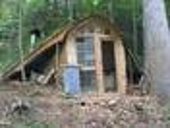
 2
2




 12
12




"The highest function of ecology is the understanding of consequences."
"Cultivate gratitude; hand out seed packets"
 1
1




 2
2




 6
6








 2
2




Wilmer Smith wrote:Thermal mass will continue to radiate heat all night when the outside median temp is over 100F. ... Should you build in such heat, you should document the results and share, because there's not many talking about it. Most mud research and literature comes from people working in the New Mexico highlands and Colorado--- quite different from the extreme heat of the Sonoran Desert, the city, and like environments.
-Kat Z
~
Composting speaks to my need for resourcefulness, making something out of nothing.
 4
4







 2
2




Praying my way through the day
 1
1




brett johns wrote:Having lived in the tropics for decades including offgrid, no electricity as this might be, I would never build with high mass materials. They retain air temp during day then emit all night, you dont need direct sun for high thermal mass to retain its 33C for many months. Best for living house I ever experienced was old railway line pole, slightly elevated home, no walls bar the bedroom but flyscreen around all sides with covered verandah all round house perimeter.


Kambô Provider • Herbalist • Purveyor of Tribal Medicines • Tropical Farmer
 4
4




Long balcony garden in the green Basque Country






 1
1









Jerry McIntire wrote:It sounds like lots of insulation, with mass on the inside of the insulation envelope, is best for the temperature swings of desert areas. Am I reading the situation well?
The constant heat of oversized cities in the hottest zones is another thing.
"We will never be truly healthy, satisfied, or fulfilled if we live apart and alienated from the environment from which we evolved." -Stephen Kellert
 1
1




 1
1








To be is to do …Kant
To do is to be ..Nietzsche
Do be do be do…Sinatra
Scooby dooby do …St. Thomas




To be is to do …Kant
To do is to be ..Nietzsche
Do be do be do…Sinatra
Scooby dooby do …St. Thomas




Cody DeBaun wrote:Any of those systems provide enough thermal mass to effectively cool a house in summer and keep it warm in winter. Integrating that wall style with passive solar design, appropriate tech heating/cooling systems and other elements of house design can create a home that is comfortable year round.
Invasive plants are Earth's way of insisting we notice her medicines. Stephen Herrod Buhner
Everyone learns what works by learning what doesn't work. Stephen Herrod Buhner




Northern Australia has building codes for cyclone rating, which I would imagine requires something fairly substantial.
John Daley Bendigo, Australia The Enemy of progress is the hope of a perfect plan
Benefits of rainfall collection https://permies.com/t/88043/benefits-rainfall-collection
GOOD DEBT/ BAD DEBT https://permies.com/t/179218/mortgages-good-debt-bad-debt
 1
1





|
Why does your bag say "bombs"? The reason I ask is that my bag says "tiny ads" and it has stuff like this:
The new purple deck of permaculture playing cards
https://www.kickstarter.com/projects/paulwheaton/garden-cards
|




